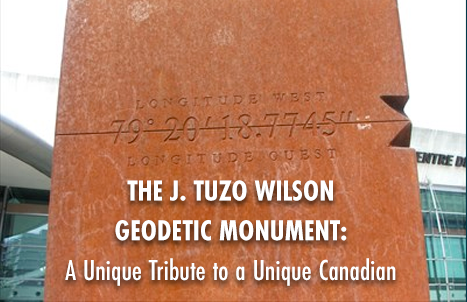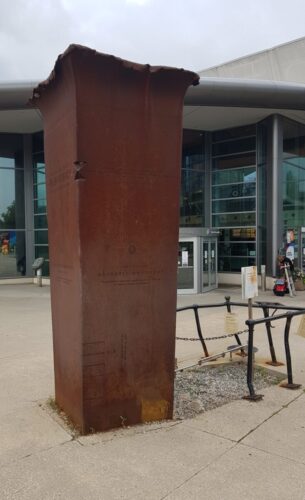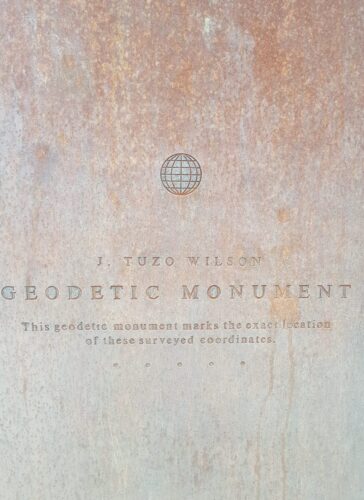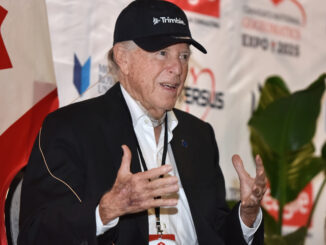
Vic Tyrer, Ontario Science Centre Staff Geographer (retired)
On June 21, 2024 the Government of Ontario announced that the Ontario Science Centre (OSC) in Toronto, originally opened in 1969, would permanently close. This decision was prompted by an engineering report that identified issues with the roof of the building related to the material known as Reinforced Autoclaved Aerated Concrete, which is prone to long-term deterioration through interaction with moisture. The decision has predictably proved controversial and other opinions (e.g. Lam, E., Canadian Architect, 2024) held that full closure was unjustified. The Architectural Conservancy of Ontario (2024) requested that the building, designed by renowned architect Raymond Moriyama, be designated under the Ontario Heritage Act as an outstanding example of the so-called “brutalist” architectural style and for its many unique features. Among the attributes noted in their lengthy document is the installation known as the J. Tuzo Wilson Geodetic Monument, honoring one of Canada’s most famous Earth Scientists. The future of this tribute is but one of many questions that arise from the unexpected closure of the OSC, but it is one of particular concern to the Earth Sciences community.
Dr. J. Tuzo Wilson was the Ontario Science Centre’s third Director General from 1974 to 1985. He passed away in 1993 at the age of 84. In tribute to Dr. Wilson, a new exhibit was unveiled on May 3, 2001 on the plaza leading to the Science Centre’s newly renovated entrance. In attendance that day was his wife Isabel, daughters Susan and Patty and family. Since then millions of visitors have walked past this unique exhibit depicting the relentless travel of the North American tectonic plate. The tribute to Dr. Wilson is a massive steel “spike” rising several meters above the plaza. Created by Science Centre staff, it is meant to commemorate Dr. Wilson for the revolutionary change he brought upon the world’s understanding of how Earth’s invisible interior works. Visitors are invited to imagine that the spike is driven deep into the Earth’s mantle and therefore fixed in place, unlike the Earth’s dynamic and mobile surface.
While formally addressed as Dr. Wilson, Science Centre colleagues, scientific peers and family, then and now continue to think of him as Tuzo. A plaque bearing his likeness and some text affixed to a wall in the Centre would not have sufficed. Instead, a fitting tribute would distil his life’s work to its simplest expression while adhering to the Centre’s design philosophy. His science had to be accurately represented. It had to be the real thing, like the lunar rock sample in the Astronomy Hall. And, the exhibit had to depict science in a manner relevant to the Centre’s visitors.
A geodetic monument was considered the appropriate way to represent Tuzo’s scientific career. A geodetic monument is a physical marker typically secured into bedrock or embedded in stable ground, in this case an architectural rendering of a giant spike anchored into the Centre’s concrete plaza. A reference point is selected on the monument at which coordinates are measured in terms of latitude, longitude, and height above mean sea level.

The Canadian Geodetic Survey (a Division of Natural Resources Canada) undertook a survey in July 1997, after the concrete base of the monument was in place. A GPS receiver was set up over the geodetic reference point in the base of the monument and for 24 hours from 12:56 p.m. on the 7th of July to 1:01 p.m. on the 8th of July signals from dozens of orbiting GPS satellites were tracked. The coordinates of the geodetic reference point (43o 43’ 0.5061” N; 79o 20’ 18.7745” W) were then transcribed into the steel and the distinctive spike was secured in place above its reference point. Today, it is common knowledge that, on average, the seemingly solid ground of the North American tectonic plate is moving from east to west at about 1 to 2 cm/year depending on location. More specifically, the J. Tuzo Wilson Geodetic Monument is moving westward at about 1.6 cm/yr. Other common tectonic terms, popular with trivia games, include the Pacific Ring of Fire, mid-ocean ridges, subduction zones, hot spots, and transform faults, with the San Andreas Fault being a world-famous example of the latter. These planetary-scale phenomena were finally brought together in a unified theory by Tuzo Wilson in the early 1960s. That theory, called Plate Tectonics, is his legacy.
In the decades since the geodetic survey at the Science Centre thousands of geodetic reference points throughout the North American plate are continuously monitored by GPS revealing new refinements in our understanding of plate motion. We now know that the overall average motion of a plate differs from that along plate boundaries where plates collide and deform in different ways. It is ironic that as Tuzo was assuming his role as the Science Centre’s Director General in the early 1970s, less than a decade after the world began to embrace plate tectonics, Ontario students were still being taught geosynclinal theory from the previous century. Students were learning that continents were fixed landmasses that grew at their margins as sediments filled deep depressions, termed geosynclines, that somehow turned into mountains.
Tectonic plate movement and drying paint are equally dull to watch. So how to depict the cumulative travel of North America in a clear manner for visitors? This is the second unique feature of the installation found at the visitor’s feet. It shows how the North American plate would have left a trail of broken concrete as it slowly moved past the immovable reference point represented by the steel spike. The 1.4 m gash in the plaza floor trending towards the west represents the estimated amount of plate motion over Tuzo’s life of 84 years. Other comparisons of accumulated plate motion can be made. For example, Canada has drifted westward about 2.5 m since Confederation. About half a metre of plate motion occurred since the survey was done twenty seven years ago. And during the life of the Ontario Science Centre, as generations have known it, a tectonic tear of about 1 m in length would have resulted.
In her remarks at the Monument’s unveiling Tuzo’s daughter Susan Wilson shared the following with guests.
“I am here on behalf of the Wilson family – particularly my sister Patty Proctor, our mother Isabel Wilson, and Patty’s family, Michael, Andrea, here beside me, Eleanor and Caroline, to thank everyone who contributed to this magnificent monument to my father. Thank you. We are very touched and proud that he is remembered here and in this way. We would like you to know that Dad too would have been deeply touched by this gesture and simply thrilled by the cleverness of the monument itself. He would have said that it was “splendid!”. Leaving aside totally the matter of it being in his honour, he would have loved the fact that this spike combines a memorial, a sophisticated scientific measuring device, and a science lesson accessible to everyone – all in one compact and striking structure. He would have noted, as do we, that the Geodetic Benchmark, and the visual lesson exemplify two things important to the person remembered; serious geological science and the dissemination of scientific knowledge to everyone, not just to members of the scientific community. He would have loved the fact that this monument is here at the Ontario Science Centre where serious science and the joy of scientific discovery and learning blend so easily together, and where he spent many happy years at the end of his working career. So, on behalf of the entire family, including my father, I thank the Ontario Science Centre and its imaginative staff, the Geological Survey of Canada, and all the corporations and individuals who contributed to the creation of this monument.”
As inscribed into the steel monument, “Principal Funding for the Monument has been generously provided by: Canadian Geological Foundation; Earth Sciences Sector – Natural Resources Canada; Stelco Inc.; Roberston and Brenda Davies; Geological Association of Canada; The Cecil and Ida Green Foundation; Isabel Wilson; Susan Wilson.”

Tuzo gave his last public lecture at the Ontario Science Centre on February 23, 1992. He titled his presentation “With Zest to Go, in Quest to Know” and over the course of an hour took the audience on a personal journey that spanned three million kilometers across seven continents. He recounted the development of plate tectonics and how it was being furthered by continuing research. For an impressive and engaging biography of Tuzo’s life, research and achievements look for the book, “Tuzo: The Unlikely Revolutionary of Plate Tectonics” by Nick Eyles, published by the University of Toronto Press.
The permanent closure of the Science Centre has far-reaching consequences, including the fate of J. Tuzo Wilson Geodetic Monument. What is to become of this tribute to a Canadian pioneer of Earth Sciences? One thing is certain, if the monument (CGS #973026) is moved even a few centimeters from its original placement its accuracy is lost. It becomes an architectural reminder of the Science Centre’s past. Maybe Tuzo’s spike should be relocated to the Department of Earth Sciences at the University of Toronto where he served as its first professor in 1946. Or, perhaps it could be sent to a location that exemplifies his insight. Iceland would be fitting. It is above a mantle plume (hot spot) that coincides with where the North American and Eurasian plates diverge along the mid-Atlantic Ridge. Perhaps it is more appropriate to move this tribute to Dr. Wilson to a place of prominence at a new and engaging Ontario Science Centre. Whatever its final destiny, this unique tribute to the legacy of a truly remarkable Canadian scientist should not be lost.
REFERENCES
Architectural Conservancy of Ontario, 2024, Heritage designation of the Ontario Science Centre; request and supporting documentation. Available from: https://www.toronto.ca/legdocs/mmis/2024/ex/comm/communicationfile-181876.pdf
Lam, E., 2024, Canadian Architect, Ontario Science Centre doesn’t require full closure: A close reading of the engineers’ report. www.canadianarchitect.com. Published online June 24, 2024.
Eyles, N. 2023. Tuzo: The unlikely revolutionary of plate tectonics. University of Toronto Press.
Photos by V. Tyrer.





Be the first to comment